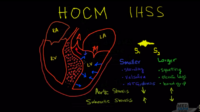Passing the 2016 ABFM MC-FP Certification Exam is no easy feat – but the right study plan will ensure that you’re adequately prepared for all the content you’ll see on the exam.
Improve your proficiency with two free questions taken from the BoardVitals ABFM MC-FP Board Exam Question Bank to put your knowledge to the test.
Question 1
A 23-year-old woman returns after an abnormal pap smear result. Her results show low-grade squamous intraepithelial lesion (LSIL) with a positive human papillomavirus (HPV) test. She has had 3 male sexual partners in her life over the last four years and has been in an exclusive relationship with the same man for the last three years. She denies consistent use of barrier protection during intercourse. Her periods are regular, lasting five days every 30 days. She denies menorrhagia, vaginal discharge, abnormal bleeding, dysuria, or past history of sexually transmitted infection. She had her first pap smear two years ago with her regular doctor in New York state; she is uncertain of the result. She is a post-graduate student at a local state college in Ohio but is from New York. What is the appropriate step in management of this patient?
A.) CT of abdomen and pelvis
B.) Obtaining her past medical records regarding previous pap smear and repeating pap smear in 6 months and 12 months
C.) Arranging loop electrosurgical excision procedure
D.) Clay shoveler’s fracture
E.) Treatment with podophyllin
Answer:
B.) Obtaining her past medical records regarding previous pap smear and repeating pap smear in 6 months and 12 months
Explanation
ANSWER: B. EXPLANATIONS: B. TRUE: The American College of Obstetricians and Gynecologists (ACOG) guidelines for management of HPV-positive LSIL cytology in adolescents, the second-most common abnormal cytology, are to repeat cervical cytology at 6 months and 12 months. Adolescents have been shown to clear HPV and have low cancer rates. However, colposcopy may also be a reasonable choice if there is a risk of loss to follow-up. Low-grade squamous intraepithelial lesions carry a risk CIN 2-3+ at initial colposcopy of 15-30%. Routine screening may resume after 2 consecutive negative cytology results or 1 negative HPV. The most common result is atypical squamous cells (ACS). Aggressive investigation is not recommended since the diagnosis is often not reproducible and carries a very low risk for cancer (0.1-0.2%) This case requires the physician to determine whether this patient will be lost to follow-up. She is at somewhat of a higher risk, as she is from out of state. However, she has presented to discuss an abnormal result and has a regular doctor in her home state who you can contact and obtain past medical records from. Furthermore, the likelihood that she will clear HPV is high. The correct answer in this scenario is therefore to get past medical records and repeat cytology at 6 and 12 months. A. FALSE: CT of abdomen and pelvis would not be helpful in this scenario. C. FALSE: Arranging colposcopy may be the correct option in some cases of LSIL such as older premenopausal women with an HPV positive result or patients that are unlikely to follow-up. D. FALSE: Arranging a loop electrosurgical excision procedure is indicated in if there is unsatisfactory colposcopy, suspected microinvasion, lack of correlation between the cytology and colposcopy/biopsies, lesions extending into the endocervical canal, suspected adenocarcinoma, recurrence after ablative or previous excisional procedures, or if invasive disease is unable to be excluded. E. FALSE: Treating with podophyllin in a tincture of benzoin is used for the treatment of genital warts.
Reference
Smith L. Abnormal Cervical Cytology and Histology in Adolescents. Am Fam Physician. 2006 Oct 15;74:1431-1434. 2. Shaw HA. Loop electrosurgical excision procedure (LEEP). Medscape. Updated June 20 2013. http://emedicine.medscape.com/article/1998067-overview. Accessed September 28, 2013.
Question 2
A 59-year-old woman presents to the emergency department generally unwell with 2 months of worsening lethargy, nausea, generalized abdominal pain, and constipation. She is a heavy smoker, has hypertension, high cholesterol, and chronic bronchitis. She takes amlodipine 5mg daily and atorvastatin 40mg daily with no recent changes to dose or frequency. She lost 15lbs despite a normal appetite. There has been no recent exacerbation of her chronic cough. She had a couple of episodes of minimal hemoptysis a few months ago but none since then. Vital signs are within normal limits. Auscultation of the lungs reveals mild decreased air entry throughout and no adventitious sounds. There is mild generalized abdominal tenderness to palpation. The rest of the physical examination is unremarkable. Laboratory investigations are shown below. Chest radiograph shows a discrete mass in the right hilum of approximately 10mm in diameter; otherwise, lung fields are clear without collapse or consolidation. Which of the following is appropriate for initial management of this patient?
A.) 4mg IV zoledronic acid
B.) IV hydration with normal saline
C.) IV hydration with 5% dextrose
D.) 12.5mg hydrochlorothiazide tablet
E.) Non-contrast CT chest
Answer
B.) IV hydration with normal saline
Explanation
ANSWER: B. EXPLANATIONS: B. TRUE: Malignancy-associated hypercalcemia is a paraneoplastic syndrome that occurs more frequently in some cancers (e.g. lung cancer, breast cancer, multiple myeloma). Signs are variable and reflect the level of serum calcium. Gastrointestinal symptoms are typical and include nausea, vomiting, loss of appetite, abdominal pain, and constipation. Patients frequently complain of lethargy and muscle weakness. Anxiety, depression, cognitive dysfunction and confusion may also develop. In markedly elevated calcium, progression to coma or cardiac arrhythmia can occur. In a patient who is a heavy smoker with a history of chronic cough with hemoptysis, a lung cancer primary is a concern. There are two types of malignancy-associated hypercalcemia, osteolytic hypercalcemia and humoral hypercalcemia, both of which may be attributable to lung cancer. In the case of osteolytic hypercalcemia and lung cancer, bony destruction results from metastases. Humoral hypercalcemia results from the release of an endocrine factor such as parathyroid hormone-related protein (PTHrP) or parathyroid hormone (PTH). Secretion of PTHrP is frequently associated with squamous cell cancer of the lung, while PTH secretion is more often related to small cell carcinoma of the lung. This patient is highly suspicious for malignancy, but a diagnosis has not been established. Treatment seeks to restore a eucalcemic state while inhibiting bone resorption. Early treatment involves IV hydration to provide resuscitation and to re-establish renal perfusion with calciuresis. A. FALSE: Clinicians generally add bisphosphonates within 24 hours if there is no improvement. Calcitonin may be added in initial therapy as an adjuvant to inhibit osteoclastic bone resorption. C. FALSE: Normal saline is the preferred crystalloid in hypercalcemia. D. FALSE: This option worsens hypercalcemia. E. FALSE: A non-contrast chest CT is not the best imaging modality for investigating malignancy.
Reference
Clines GA. Mechanisms and treatment of hypercalcemia of malignancy. Curr Opin Endocrinol Diabetes Obes. 2011;18:339–346.
Ready for more practice questions? Take the BoardVitals Family Medicine Board Review Question Bank for a spin with a free trial.
Best of luck on the upcoming Family Medicine Certification Exam!
Test your knowledge with another Family Medicine question, this time led by BoardVitals’ Chief Medical Officer, Dr. Andrea Paul in our video series, Practice Connection. Check out more Practice Connection videos here.




